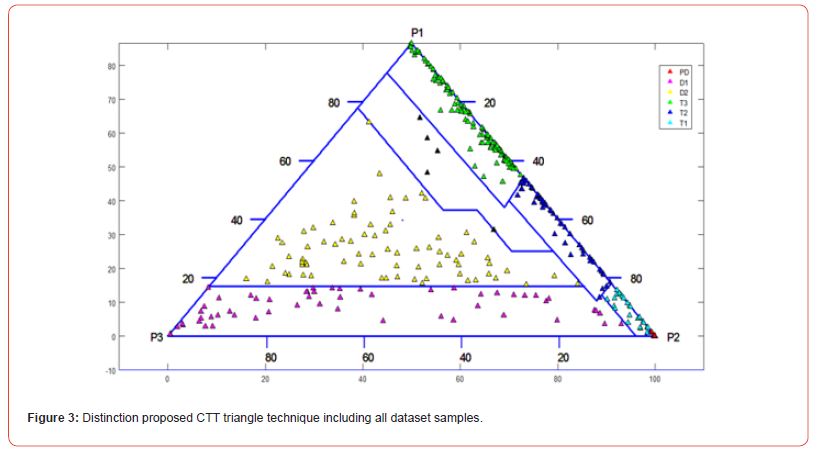 Mini Review Article
Mini Review Article
Dissolved Gas Analysis of Oil Transformers
Osama E Gouda, Electrical Power Department, Faculty of Engineering, Cairo University, Giza 12613, Egypt.
Received Date: May 18, 2023; Published Date: May 26, 2023
Introduction
Dissolved Gas Analysis (DGA) in power provides useful information about the condition of the oil and helps to identify the incipient fault types within the transformer. It uses the concentrations of various dissolved gases in the transformer oil due to decomposition of the oil and paper insulation. DGA has gained worldwide acceptance as a technique for the detection of incipient faults in transformers. Due to the thermal and electrical stresses that the insulation of op erating transformers experience, paper and oil decomposition occurs, generating gases that dissolve in the oil and reduce its dielectric strength. Gases generated through oil decomposition include hydrogen (H2), methane (CH4), acetylene (C2H2), ethylene (C2H4), and ethane (C2H6). On the other hand, carbon monoxide (CO) and carbon dioxide (CO2) are generated as a result of paper decomposition. Combustible gas generation versus oil decomposition temperature for oil transformer is given in references [1,2].
Accurate Methods for Condition Assessment of Oil Immersed Transformers
Heptagon technique for interpretation of oil immersed transformer

Proposed heptagon technique is represented as shown in Figure 1, which includes all fault type zones with the exact positions of boundary points on the heptagon sides [3]. Each zone represents a particular fault type of oil-immersed transformer. One advantage of this technique is that it detects the faults due to cellulose degradation using dissolved gas analysis, where boundaries of the Heptagon which is expressed from 0 to 100 in the clockwise direction. HCCD is high concentration of cellulose degradation; MCCD is medium concentration of cellulose degradation; LCCD represents low concentration of cellulose degradation; T1 is the thermal fault <300°C; T2 is the thermal fault from 300 to 700°C; T3 is the thermal fault >300°C; TD is electrical and thermal fault; D1is low-energy discharges; D2 is high-energy discharges and PD is partial discharge fault (Figure 1).
Three ratios technique for the interpretation of oil transformers based dissolved gas analysis (TRT ratio)
In order to create an accurate and reliable technique of DGA diagnosis, five main diagnosis gases H2, CH4, C2H6, C2H4, and C2H2 are selected from dissolved gases generated by faults in transformers which are represented in three different types of gas ratios that are capable of clear fault distinction. The TRT diagnosis technique can also perform a detailed diagnosis of the internal transformer fault types defined by IEC 60599. This technique is tested and compared with other techniques [4]. It is able to classify fault area clearly, simply, excellent credibility and more accurate as compared with other techniques. The TRT diagnosis technique has 99.21% accuracy as compared with 81.52% for Duval, 75.61% for Doernenburg, 48.91% for IEC and 40.12% for Rogers for 700 cases.
Modified triangle technique for prediction and condition assessment of oil immersed transformers using composite dissolved gas analysis (CTT triangle techniques)
Modifications on Duval Triangle technique is done by using new 3-gas concentration ratios converted to new 3-ratio percentages of DGA based on the consideration of all five hydrocarbon combustible gases. The proposed triangle technique has proved quite efficient to determine the general fault types (T3, T2, T1, PD, D1, D2) occurring in transformers in service which is defined by IEC 60599. It overcame the conflict that takes place in the traditional techniques to analyze the incipient fault conditions [5]. This technique is tested and compared with all conventional techniques. By investigating 700 cases, the CTT triangle technique has 99.06% accuracy as compared with 81.52% for Duval, 75.61% for Doernenburg, 48.91% for IEC and 40.12% for Rogers. These dissolved gas analysis databases have been signed on the proposed CTT triangle technique to confirm or re-adjust slightly these boundaries of each fault region on the triangle sides with maximum accuracy whenever possible as shown in Figure 2.

The dissolved gas analysis databases have been signed on the proposed CTT triangle technique to confirm or re-adjust slightly the boundaries of each fault region on the triangle sides with maximum accuracy as shown in Figure 3.

Conclusion
The percentages of overall successful predictions of the Heptagon method, three ratios technique, and triangle method as compared to other techniques taking into account the main faults in the transformers; have percentages accuracy of 99.75%, 99.01%, and 98.52%, respectively for about700 investigated cases . On the other hand for the same investigated cases, Duval triangle method accuracy reached to 91.39%. Dornenburg method accuracy reached to76.76%. Rogers, and IEC techniques have the accuracy of 49.40%, and 53.34%, respectively.
Acknowledgement
None.
Conflict of Interest
No Conflict of interest.
References
- F Jakob, P Noble, JJ Dukarm (2012) A Thermodynamic Approach to Evaluation of the Severity of Transformer Faults. IEEE Transactions Power Delivery 27(2): 554-559.
- E Dornenburg, W Strittma (1974) Monitoring oil-cooled transformers by gas-analysis. Brown Boveri Rev 61(5): 238-247.
- OE Gouda, SH El-Hoshy, HH El-Tamaly (2018) Proposed heptagon graph for DGA interpretation of oil transformers. IET Generation., Transmission. Distribution 12(2): 490-498.
- OE Gouda, SH El-Hoshy, HH El-Tamaly (2018) proposed three ratios technique for the interpretation of mineral oil transformers based dissolved gas analysis. IET Generation., Transmission. Distribution 12(11): 2650–2661.
- O E Gouda, S H El-Hoshy, H T Hassan (2019) Condition assessment of power transformers based on dissolved gas analysis. IET Generation., Transmission, Distribution 13(12): 2299–2310.
-
Osama E Gouda*. Dissolved Gas Analysis of Oil Transformers. Insi in Chem & Biochem. 2(4): 2023. ICBC. MS.ID.000544.
-
Materials Science, fibers, concrete, fiber-reinforced concrete, polymer, synthetic fiber, Artificial fiber.
-

This work is licensed under a Creative Commons Attribution-NonCommercial 4.0 International License.






